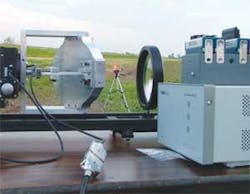OPTICAL-SPECTRUM ANALYSIS: Polarimetry improves spectral measurement of swept-wavelength sources

Although optical-spectrum analysis and polarization measurement methods are not generally related, a collaborative effort by scientists at Tianjin University (Tianjin, China), General Photonics (Chino, CA), and the University of Southern California (Los Angeles, CA) has resulted in a polarimeter-based optical-spectrum analyzer (P-OSA) that measures with a speed and resolution that cannot be achieved using traditional grating-based, filter-based, or interferometric methods.1 In fact, the method works so well that it has been used to successfully measure the instantaneous wavelength, direction of wavelength change, and even the spectral shape of both step-tuned and swept-wavelength sources–data that cannot be obtained by conventional spectral measurement techniques.
Conventional OSA measurement techniques prevent simultaneous achievement of high resolution, wide spectral range, and fast measurement speed. For example, measurement range and spectral resolution are inversely proportional in Fabry-Perot filter-based OSAs; one must be sacrificed for the other. And while diffraction-grating-based OSAs with a charge-coupled-device (CCD) sensor can be fast, resolution and scanning range are limited by the size of the CCD and high diffraction orders from the grating if the spectral range is too large or the grating period is too small.
Combined advantages
Essentially, the new polarimetric technique eliminates these tradeoffs and is rather simple: a differential-group-delay (DGD) element is placed in front of a high-speed polarimeter (such as the POD-101D from General Photonics), and the state of polarization (SOP) and degree of polarization (DOP) are analyzed as the wavelength is swept. The P-OSA can currently achieve measurement speeds on the order of megahertz, but can potentially reach speeds of tens of gigahertz, limited only by the bandwidth of the photodetectors, RF amplifiers, and digital-processing electronics in the instrument. And unlike conventional OSAs, it can determine the direction of a frequency change if the measurement speed is fast in comparison with the rate of SOP change caused by the spectral change of the laser source. Finally, the P-OSA can measure spectral shape (power vs. frequency) of a swept light source (see figure).
In the experimental setup, both a swept-wavelength and a step-tuned laser were alternately input to a polarization control (for equal splitting between two polarization eigenstates), into a 5.7 ps delay birefringent crystal–the fixed DGD, and then into the commercially available POD-101D polarimeter, which performs DOP sampling and SOP trace recording at a sampling rate near 1 MHz. Postprocessing algorithms transform the DOP and SOP results from the sources into data showing wavelength and intensity as a function of time. The polarization data can describe not only the sinusoidal behavior of a light source, but also the “spiky” details in between when a wavelength is stepped in 0.05 nm increments. Additional processing of the SOP data by calculating the accumulated polarization rotation angle and taking the direction of rotation into account can reveal the time-resolved swept frequency of a source.
To observe the spectrum of a fixed-wavelength source, a slightly different experimental setup utilizes a variable-delay DGD. As the DGD value is varied from zero to beyond the coherence length of the source being measured, DOP and SOP information is gathered. Curve-fitting SOP versus DGD to a linear relation determines the center frequency of the source, and the Fourier transform of DOP as a function of DGD yields the spectral power information.
One can even obtain three-dimensional spectral-shape information of a swept-wavelength source with the same setup. To do this, the DGD value is increased by a known step for each wavelength scan. Both DOP and SOP are recorded and are converted to a two-dimensional matrix containing both swept-wavelength values and DGD points. Additional calculations convert this information to spectrum as a function of swept wavelength for a three-dimensional shape rendering. This spectral shape and width information are extremely important in determining the coherence length of a source useful in optical coherence tomography (OCT) applications.
“Right now, there are no instruments on the market to measure the instantaneous wavelengths and spectra of wavelength-swept light sources for OCT and fiber-sensor applications,” says Steve Yao, president and CEO of General Photonics. “We plan to bring this exciting new instrument to the market in about a year to fulfill such market demands.”
REFERENCE
- X. Steve Yao et al., Optics Express 16(22) p. 17854 (Oct. 27, 2008).
About the Author

Gail Overton
Senior Editor (2004-2020)
Gail has more than 30 years of engineering, marketing, product management, and editorial experience in the photonics and optical communications industry. Before joining the staff at Laser Focus World in 2004, she held many product management and product marketing roles in the fiber-optics industry, most notably at Hughes (El Segundo, CA), GTE Labs (Waltham, MA), Corning (Corning, NY), Photon Kinetics (Beaverton, OR), and Newport Corporation (Irvine, CA). During her marketing career, Gail published articles in WDM Solutions and Sensors magazine and traveled internationally to conduct product and sales training. Gail received her BS degree in physics, with an emphasis in optics, from San Diego State University in San Diego, CA in May 1986.